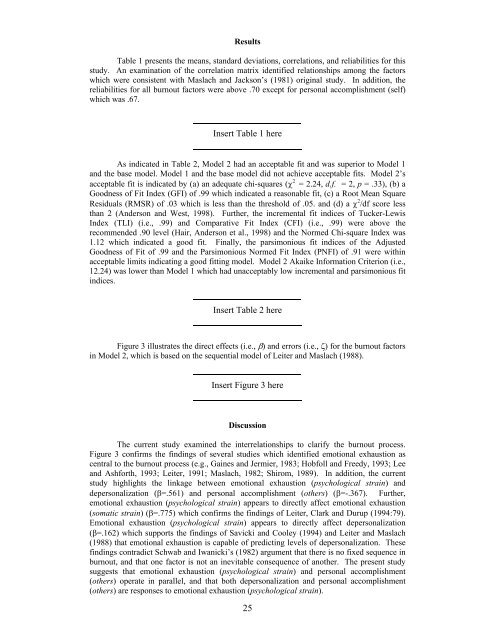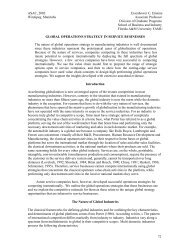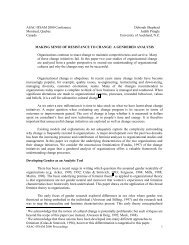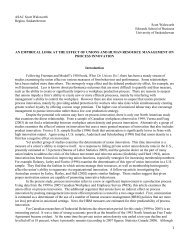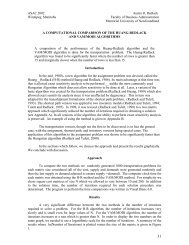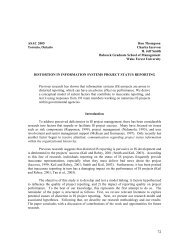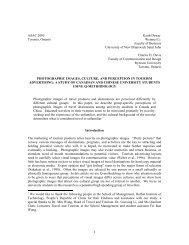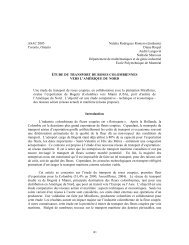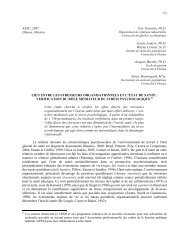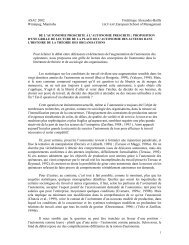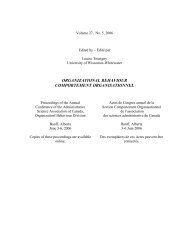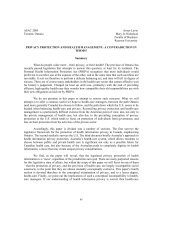studies (Friedman and Sarros, 1989; Jackson, Turner et al., 1987; Leiter and Meechan, 1986;Sarros and Sarros, 1992) have elected to use only the intensity and not the frequency scalebecause unlike stress, burnout is an on-going manifestation where there is no respite andtherefore, the intensity of feelings is more critical than the frequency of occurrence. Such anapproach is consistent with several test-retest studies conducted using the MBI (Wade et al.,1986) which found burnout to be a chronic rather than a transient syndrome.An investigation of the factorial validity of the MBI resulted in item 12 (‘I feelenergetic’) being deleted because it did not load on the appropriate factor. This action isconsistent with the recommendations of Bryne (1993) and Schaufeli and Van Dierendonck(1993). Two further items were excluded: item 13 (‘I feel frustrated by my job’), and item 14(‘I feel I’m working too hard on my job’) because of very low squared multiple correlationscores. In addition, both items refer to common aspects of law enforcement such as‘frustration’ and ‘working too hard’ for which respondents may not have been able to discernthe intensity of their feelings. An acceptable confirmatory factor analysis for this study wasachieved (χ 2 = 290.18, d.f.=109, p=.000; GFI=.91; TLI=.92; CFI=.94) which measured fivefactors of burnout, namely emotional exhaustion (psychological strain) - 3 items, emotionalexhaustion (somatic strain) - 4 items, depersonalization - 5 items, personal accomplishment(others) - 4 items, and personal accomplishment (self ) - 3 items (for further details regardingCFA see Densten, 2001). In addition, the word ‘recipient’ replaced ‘patient’ among the MBIitems.SampleThe sample was predominantly male, with an average age of 45 years, most weremarried (87.2 per cent) with two or more children, and a majority (63.2 per cent) had onlyattained high school education (non-college education). Most respondents (81.4 per cent)joined the law enforcement organization when under 21 years of age. Senior sergeantsformed the largest group (48.7 per cent) among the five senior officer levels examined. Theaverage years of service was 25 years with most managers (70 per cent) being in their currentposition for three years and five months. Most managers (73 per cent) worked in adepartment of 75 or fewer personnel.Analyses of dataComposite factor scores of each factor were generated using factor score regressionweights that maximize the reliability of factor scores (see Wertz, Rock et al., 1978). Thesecomposite factors were examined using Multilevel Analysis procedures (see Woodhouse,1995) and identified as single level data. According to Keeves and Cheug (1990), single levelstructural equation models should not be fitted with multilevel data, otherwise unreliable orinelegant analysis may result. These single level composite factor scores were then fitted tothe LISREL method for submodel 3b (Jöreskog and Sörbom, 1989) that contains only y(observed) and η (latent) variables which were treated as endogenous. Three structuralequation models were generated, namely Model 1: Golembiewski and Munzenrider’s (1988)Phase Model approach, Model 2: Leiter and Maslach (1988) Sequential Model approach, andthe base model where emotional exhaustion (psychological strain) directly influenced all ofthe remaining burnout factors.The structural equation models were assessed using several indices in three areas,namely overall fit indices (i.e., Chi Square, Goodness of Fit and Root Mean Square),comparative fit indices (i.e., Adjusted Goodness of Fit, Normed Fit Index, and Non-normedFit Index), and parsimonious fit indices (i.e., Normed Chi-square, Parsimonious Normed FitIndex, and Akaike Information Criterion).24
ResultsTable 1 presents the means, standard deviations, correlations, and reliabilities for thisstudy. An examination of the correlation matrix identified relationships among the factorswhich were consistent with Maslach and Jackson’s (1981) original study. In addition, thereliabilities for all burnout factors were above .70 except for personal accomplishment (self)which was .67.Insert Table 1 hereAs indicated in Table 2, Model 2 had an acceptable fit and was superior to Model 1and the base model. Model 1 and the base model did not achieve acceptable fits. Model 2’sacceptable fit is indicated by (a) an adequate chi-squares (χ 2 = 2.24, d.f. = 2, p = .33), (b) aGoodness of Fit Index (GFI) of .99 which indicated a reasonable fit, (c) a Root Mean SquareResiduals (RMSR) of .03 which is less than the threshold of .05. and (d) a χ 2 /df score lessthan 2 (Anderson and West, 1998). Further, the incremental fit indices of Tucker-LewisIndex (TLI) (i.e., .99) and Comparative Fit Index (CFI) (i.e., .99) were above therecommended .90 level (Hair, Anderson et al., 1998) and the Normed Chi-square Index was1.12 which indicated a good fit. Finally, the parsimonious fit indices of the AdjustedGoodness of Fit of .99 and the Parsimonious Normed Fit Index (PNFI) of .91 were withinacceptable limits indicating a good fitting model. Model 2 Akaike Information Criterion (i.e.,12.24) was lower than Model 1 which had unacceptably low incremental and parsimonious fitindices.Insert Table 2 hereFigure 3 illustrates the direct effects (i.e., β) and errors (i.e., ζ) for the burnout factorsin Model 2, which is based on the sequential model of Leiter and Maslach (1988).Insert Figure 3 hereDiscussionThe current study examined the interrelationships to clarify the burnout process.Figure 3 confirms the findings of several studies which identified emotional exhaustion ascentral to the burnout process (e.g., Gaines and Jermier, 1983; Hobfoll and Freedy, 1993; Leeand Ashforth, 1993; Leiter, 1991; Maslach, 1982; Shirom, 1989). In addition, the currentstudy highlights the linkage between emotional exhaustion (psychological strain) anddepersonalization (β=.561) and personal accomplishment (others) (β=-.367). Further,emotional exhaustion (psychological strain) appears to directly affect emotional exhaustion(somatic strain) (β=.775) which confirms the findings of Leiter, Clark and Durup (1994:79).Emotional exhaustion (psychological strain) appears to directly affect depersonalization(β=.162) which supports the findings of Savicki and Cooley (1994) and Leiter and Maslach(1988) that emotional exhaustion is capable of predicting levels of depersonalization. Thesefindings contradict Schwab and Iwanicki’s (1982) argument that there is no fixed sequence inburnout, and that one factor is not an inevitable consequence of another. The present studysuggests that emotional exhaustion (psychological strain) and personal accomplishment(others) operate in parallel, and that both depersonalization and personal accomplishment(others) are responses to emotional exhaustion (psychological strain).25
- Page 1 and 2: Volume 24, No. 5, 2003Edited by/Éd
- Page 4 and 5: Pursey HeugensGreg IrvingRoderick I
- Page 6 and 7: TABLE OF CONTENTS - TABLE DES MATI
- Page 8 and 9: study of power displays in mixed-ge
- Page 10 and 11: on expectations and behaviour (Berg
- Page 12 and 13: TaskThis study required the use of
- Page 14 and 15: Task-Gender (male-stereotyped or fe
- Page 16 and 17: It is important to understand the s
- Page 18 and 19: Crown, C.L. & Cummins, D.A. (1998).
- Page 20 and 21: Smith-Lovin, L., & Brody, C. (1989)
- Page 22 and 23: Table 2Summary of Descriptive Stati
- Page 24 and 25: Table 4Summary of Interaction of Ge
- Page 26 and 27: ASAC 2003Halifax, Nova ScotiaIain L
- Page 28 and 29: the interrelationships among the MB
- Page 32 and 33: This study demonstrated that emotio
- Page 34 and 35: Anxiety, Stress and Coping, in pres
- Page 36 and 37: Washington, DC: Taylor and Francis,
- Page 38 and 39: Table 2Overall Goodness-of-Fit Indi
- Page 40 and 41: ζ 3Depersonalizationη 3β 3,1 (+)
- Page 42 and 43: ASAC 2003Halifax, Nova ScotiaWendy
- Page 44 and 45: views independently, gave rise to S
- Page 46 and 47: track assistant, associate, and ful
- Page 48 and 49: ole conflict are positively related
- Page 50 and 51: Table 3. Regression of climate and
- Page 52 and 53: interests.We speculate the null eff
- Page 54 and 55: DOOP and short for DOOP scales,”
- Page 56 and 57: Pelled, L. H., “Demographic diver
- Page 58 and 59: esulting increase in discretion ove
- Page 60 and 61: al., 1995). However, the distinctio
- Page 62 and 63: ise to strong pressures for conform
- Page 64 and 65: presented with a complete list of a
- Page 66 and 67: Table 3QAP Regression Coefficients
- Page 68 and 69: ConclusionResearchers of social inf
- Page 70 and 71: suggestions for further research.
- Page 72 and 73: performing on the job.” Presumabl
- Page 74 and 75: positively related to performance i
- Page 76 and 77: proposed hypotheses were supported.
- Page 78 and 79: ConclusionThis research has made se
- Page 80 and 81:
Be more enthusiastic and exert extr
- Page 82 and 83:
Table 2Correlations Among the Laten
- Page 84 and 85:
performance expectations on feedbac
- Page 86 and 87:
changements qui s’opèrent dans l
- Page 88 and 89:
structures, politiques, systèmes,
- Page 90 and 91:
comportements liés à la communica
- Page 92 and 93:
Tableau 2Échelles de mesure de la
- Page 94 and 95:
prédiction des compétences clés
- Page 96 and 97:
organisation n’est pas uniforme e
- Page 98 and 99:
complètement ce construit. Ces cha
- Page 100 and 101:
Wagner, R.K. and Sternberg, R.J. (1
- Page 102 and 103:
What is a toxin handler?In two arti
- Page 104 and 105:
potentially limited scope and conte
- Page 106 and 107:
work role demands. In this survey,
- Page 108 and 109:
The three factors in this rotated f
- Page 110 and 111:
and service orientation, the abilit
- Page 112 and 113:
ASAC 2003Halifax, Nova ScotiaLisa M
- Page 114 and 115:
self-appraisal group reacted more n
- Page 116 and 117:
effect of voice are the value-expre
- Page 118 and 119:
“Strongly Disagree” to “Stron
- Page 120 and 121:
esults suggest that incorporating s
- Page 122 and 123:
Personality and Social Psychology,
- Page 124 and 125:
Table 1Means, Standard Deviations,
- Page 126 and 127:
Table 3Test of the Mediating Role o
- Page 128 and 129:
ASAC 2003Halifax, Nova ScotiaAnn Fr
- Page 130 and 131:
individual level, polychronicity is
- Page 132 and 133:
construct.Drawing on computer-media
- Page 134 and 135:
Consequence: Impact on Work Overloa
- Page 136 and 137:
Conversation complexity may also mo
- Page 138:
Implications for practiceFuture res
- Page 141 and 142:
ReferencesAncona, D.G., Goodman, P.
- Page 143 and 144:
no. 3 (1994): 381-391.Macan, T.H.,
- Page 145 and 146:
ASAC 2003Halifax, Nova ScotiaIan R.
- Page 147 and 148:
Assessing Measures: Affective Commi
- Page 149 and 150:
implications of psychological contr
- Page 151 and 152:
commitment, affective commitment, c
- Page 153 and 154:
Motivational Process Variables. Amo
- Page 155 and 156:
DiscussionThe main purpose of this
- Page 157 and 158:
approaches zero. In the present stu
- Page 159 and 160:
Extension and test of a three-compo
- Page 162 and 163:
Table 1Descriptive Statistics and Z
- Page 164 and 165:
Table 3Standardized Factor Loadings
- Page 166 and 167:
Table 5Hierarchical Regression Anal
- Page 168 and 169:
ASAC 2003Halifax, Nova ScotiaJoan F
- Page 170 and 171:
ASAC 2003Halifax, Nova ScotiaArla D
- Page 172 and 173:
ASAC 2003Halifax, Nova ScotiaIvy Ky
- Page 174:
ASAC 2003Halifax, Nova ScotiaNina D


